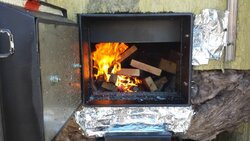I'm building a homemade boiler
- Thread starter warno
- Start date
-
Active since 1995, Hearth.com is THE place on the internet for free information and advice about wood stoves, pellet stoves and other energy saving equipment.
We strive to provide opinions, articles, discussions and history related to Hearth Products and in a more general sense, energy issues.
We promote the EFFICIENT, RESPONSIBLE, CLEAN and SAFE use of all fuels, whether renewable or fossil.
You are using an out of date browser. It may not display this or other websites correctly.
You should upgrade or use an alternative browser.
You should upgrade or use an alternative browser.
- Status
- Not open for further replies.
I simply layed them in bed of sand and used a rubber mallet to settle them in tight. I found if you wet the sand a little first it helps to pack it better. I used a small space heater to "bake" the moisture out. A small fire would do the same.
TCaldwell
Minister of Fire
That thought did cross my mind. If I find that is not getting enough air with the fan going I'll simply add another vent down low to pull in fresh air for combustion.
All is going well though. I got my feed door mounted and all that's left is the duct work. My employer shut the plant down for the week of thanksgiving so I plan to fire it for the first time next week.
All is going well though. I got my feed door mounted and all that's left is the duct work. My employer shut the plant down for the week of thanksgiving so I plan to fire it for the first time next week.
Well I didn't beat the first snow since we are getting snow here in Illinois this morning.
But the duct work is done now. All that's left is the thermostat for the forced air in the garage, filing the water jacket and firing. Monday will be my first fire. I'll get some more pics up soon.
But the duct work is done now. All that's left is the thermostat for the forced air in the garage, filing the water jacket and firing. Monday will be my first fire. I'll get some more pics up soon.
Just another little update. Since the snow has stopped the temperature outside has dropped to about 20 with the wind blowing about 10 mph. The boiler with a simple little space heater in the firebox right now has the boiler shed holding steady at 60
with the wind blowing about 10 mph. The boiler with a simple little space heater in the firebox right now has the boiler shed holding steady at 60 inside and the snow on the shed roof hasn't melted off. Hopefully this remains the norm with the boiler running.
inside and the snow on the shed roof hasn't melted off. Hopefully this remains the norm with the boiler running.
 with the wind blowing about 10 mph. The boiler with a simple little space heater in the firebox right now has the boiler shed holding steady at 60
with the wind blowing about 10 mph. The boiler with a simple little space heater in the firebox right now has the boiler shed holding steady at 60 inside and the snow on the shed roof hasn't melted off. Hopefully this remains the norm with the boiler running.
inside and the snow on the shed roof hasn't melted off. Hopefully this remains the norm with the boiler running.This morning I fired the boiler for the first time. I will do a write up on the results tomorrow being today was simply to warm it up for the pretreatment. But I will say I was pretty happy with how quickly the water temp came up with a fairly small fire inside.
Little story then a quick question to anyone still watching this thread.
This morning I came out to a dead fire with charred wood in the fire box. I think I need more air flow to keep my boiler idling when there is no heat demand but I'm not sure how much. Could anyone give any pointers to help out with this?
This morning I came out to a dead fire with charred wood in the fire box. I think I need more air flow to keep my boiler idling when there is no heat demand but I'm not sure how much. Could anyone give any pointers to help out with this?
maple1
Minister of Fire
That might come down to trial & error.
My old boiler had a slot cut into the main loading door. Think it was up high, kind of behind the fire curtain inside. It wasn't very big, and they must have done some playing with slot sizes at the boiler factory to come up with how big it should be - it wasn't adjustable. I always wondered why it was there, then eventually just assumed it was to prevent the fire from snuffing out when the draft damper closed. If you had a natural draft setup with a draft damper, you could incorporate an adjustable stop for when the damper closed & play with that, but not sure the best approach for your setup. Forget now - does your fan have a shutter that closes when the fan closes? If so maybe adjust something so it doesn't close up tight?
My old boiler had a slot cut into the main loading door. Think it was up high, kind of behind the fire curtain inside. It wasn't very big, and they must have done some playing with slot sizes at the boiler factory to come up with how big it should be - it wasn't adjustable. I always wondered why it was there, then eventually just assumed it was to prevent the fire from snuffing out when the draft damper closed. If you had a natural draft setup with a draft damper, you could incorporate an adjustable stop for when the damper closed & play with that, but not sure the best approach for your setup. Forget now - does your fan have a shutter that closes when the fan closes? If so maybe adjust something so it doesn't close up tight?
TCaldwell
Minister of Fire
I don't remember what your boiler water jacket holds or if you have storage, and neither of us know the actual firing rate. Do you have a heat dump or zone that comes on when the boiler gets near a overheat situation. knowing the above would help with the aformentioned thoughts. With no protection i would try adjusting the differential on the johnson A419, with protection Maple's thought. You might be able to alarm a low flue temp to open the damper to say 10pct and close it when the flue temp reaches x deg, and be overiden when there is a call for heat.
So I think I got the burning out thing figured out. I added in a ball valve that can draw air in the bottom and it seemed to keeps the coals got today. I lit the fire this morning at 6 and it was burned down to coals at 5 this afternoon. It was a load of pine lumber scraps.
To answer the questions I do not have a heat dump zone. I was going to use the garage for that if I ever needed to but so far right now it hasn't needed to happen. And my water jacket holds about 120 gallons. No storage this season.
So my initial thoughts are, I'm liking it. I turned the garage up to 65 on the thermostat and it held just fine. It smokes alittle more then I would like while it's idleing, but that should change once the cold weather really sets in since the idle time will be alot less. With the first fire I was heating my pretreatment solution which I had to later drain then refill with fresh treated water. It took the first fire about 1 hour to heat the water to 150 degrees. After draining and refilling and firing again I had to leave for a couple hours. When I came back home the boiler was sitting at 170 degrees and garage was toasty. It's still a learning curve right now but I think I'll get it down.
So here's some pics.
My fill adaptor let's me fill through the over head coils to help push the air out of the system.
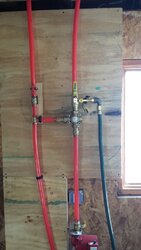
One of my pump isolation valves came with a hose adaptor on it too this will help with draining and taking water samples.
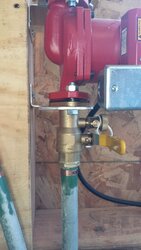
I also made up a rain cap for the chimney. I need to make it alittle higher though so it's not on right now, but here's what it looks like.
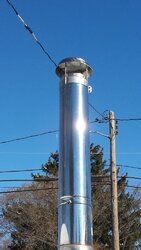
First load of wood
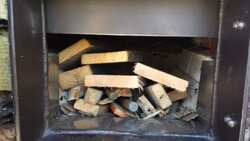
And The first fire coming to life.
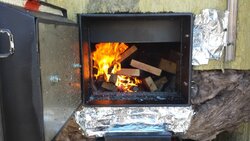
I had some serious condinsation issues in the heat exchanger until my water temp reached 130.
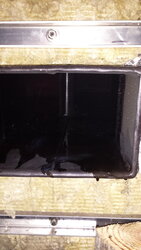
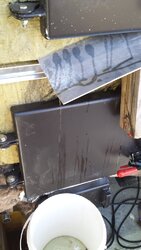
And what was left of the first fire
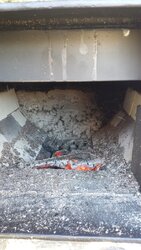
The second fire at night.
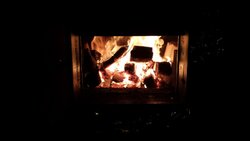
Water vapor coming from chimney while fan is running. It goes up about 5-10 feet then disappears.
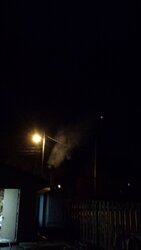
And my early Christmas gift from the Father in law
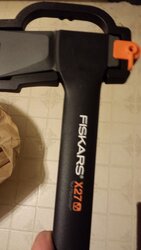
So what's everyone think?
To answer the questions I do not have a heat dump zone. I was going to use the garage for that if I ever needed to but so far right now it hasn't needed to happen. And my water jacket holds about 120 gallons. No storage this season.
So my initial thoughts are, I'm liking it. I turned the garage up to 65 on the thermostat and it held just fine. It smokes alittle more then I would like while it's idleing, but that should change once the cold weather really sets in since the idle time will be alot less. With the first fire I was heating my pretreatment solution which I had to later drain then refill with fresh treated water. It took the first fire about 1 hour to heat the water to 150 degrees. After draining and refilling and firing again I had to leave for a couple hours. When I came back home the boiler was sitting at 170 degrees and garage was toasty. It's still a learning curve right now but I think I'll get it down.
So here's some pics.
My fill adaptor let's me fill through the over head coils to help push the air out of the system.

One of my pump isolation valves came with a hose adaptor on it too this will help with draining and taking water samples.

I also made up a rain cap for the chimney. I need to make it alittle higher though so it's not on right now, but here's what it looks like.

First load of wood

And The first fire coming to life.

I had some serious condinsation issues in the heat exchanger until my water temp reached 130.


And what was left of the first fire

The second fire at night.

Water vapor coming from chimney while fan is running. It goes up about 5-10 feet then disappears.

And my early Christmas gift from the Father in law

So what's everyone think?
Attachments
OH_Varmntr
Burning Hunk
jatoxico
Minister of Fire
+1 Anyone would be proud to have put that all together. Nice craftsmanship on the build.
jb6l6gc
Minister of Fire
Very nice been watching for a while. Boilers aren't my forte but looks like you've built quite the unit and built it like a tank too. Should last a long time

I am throughly impressed!So I think I got the burning out thing figured out. I added in a ball valve that can draw air in the bottom and it seemed to keeps the coals got today. I lit the fire this morning at 6 and it was burned down to coals at 5 this afternoon. It was a load of pine lumber scraps.
To answer the questions I do not have a heat dump zone. I was going to use the garage for that if I ever needed to but so far right now it hasn't needed to happen. And my water jacket holds about 120 gallons. No storage this season.
So my initial thoughts are, I'm liking it. I turned the garage up to 65 on the thermostat and it held just fine. It smokes alittle more then I would like while it's idleing, but that should change once the cold weather really sets in since the idle time will be alot less. With the first fire I was heating my pretreatment solution which I had to later drain then refill with fresh treated water. It took the first fire about 1 hour to heat the water to 150 degrees. After draining and refilling and firing again I had to leave for a couple hours. When I came back home the boiler was sitting at 170 degrees and garage was toasty. It's still a learning curve right now but I think I'll get it down.
So here's some pics.
My fill adaptor let's me fill through the over head coils to help push the air out of the system.
View attachment 167870
One of my pump isolation valves came with a hose adaptor on it too this will help with draining and taking water samples.
View attachment 167871
I also made up a rain cap for the chimney. I need to make it alittle higher though so it's not on right now, but here's what it looks like.
View attachment 167872
First load of wood
View attachment 167873
And The first fire coming to life.
View attachment 167874
I had some serious condinsation issues in the heat exchanger until my water temp reached 130.
View attachment 167875
View attachment 167881
And what was left of the first fire
View attachment 167877
The second fire at night.
View attachment 167878
Water vapor coming from chimney while fan is running. It goes up about 5-10 feet then disappears.
View attachment 167879
And my early Christmas gift from the Father in law
View attachment 167880
So what's everyone think?
I came out this morning to another cold garage and 137 degree water temps. The added air kept the coals toasty all night but only near the very back of the burn chamber. Where my air induction is located it would just blow right under the coals and up the front then out, so basically right past everything. I'm going to put some obstructions in my ash pan to help distribute the fan air better, hopefully this will help getting it to burn through the night.
Last edited:
I think this was/is a very impressive job - well done.So what's everyone think?
hondaracer2oo4
Feeling the Heat
What is your differential set at? Also have you got a good hardwood coal bed established? Softwood leaves very little to no coal bed, if the stove idles for an extended period of time, long differential and or very small heat load, the softwood coals will burn up before the next call for heat leaving you with nothing to continue the process. Get a 3-4 inch bed if hardwood coals built up and tighten your differential to 10 degrees and you will be fine I think.
I have only been burning pine lumber scrap so far. My only hardwood I have right now is hedge. I guess I could toss a few pieces of that in there and let it burn down.
My differintial was set at 5 degrees, I turned it down to 4 degrees maybe I'll turn it down to 3. I have noticed the fire burns the "core" out of the wood stack and leaves no coals.
My differintial was set at 5 degrees, I turned it down to 4 degrees maybe I'll turn it down to 3. I have noticed the fire burns the "core" out of the wood stack and leaves no coals.
hondaracer2oo4
Feeling the Heat
That is your issue right there. Don't waste your time doing any more modifications to the stove. It will burn hardwood fine. I ran a 170 on 180 off in my old conventional which ran fine like that. Your differential is so tight now that I don't think tightening it anymore is going to help much. Your problem is that pinewood scrap crap. If I were you and I really wanted to burn that stuff I would put one split of the hedge at the bottom and the rest of the crAp wood around that. In my opinion the scrap wood is going to only frustrate you and cause you to babysit the stove.
OK, next time I load I'll toss in some hedge pieces. I just checked it mid day today and since I pulled all the coals to the front this morning they seem to be still cooking. Problem is it's about 50 degrees outside so the garage isn't calling for much heat. I think tomorrow I will see if it will heat through the day with no fire then refire for the night run since temps are dipping into 30s for lows. I'll give it a shot tonight with the hedge pieces.
It sucks but it's kind of nice they shut the plant down at work this week. I can be home to figure this thing out before going back to work.
It sucks but it's kind of nice they shut the plant down at work this week. I can be home to figure this thing out before going back to work.
Last edited:
hondaracer2oo4
Feeling the Heat
Your likely to have some moisture issues if you regularly try to heat off of just the residual heat mass since you only have 100 gallons if I remember correctly. The stove water will be cooled down pretty quickly, and you'll will get that stove sweating again before it clears through 140 degrees.
When I checked it a little bit ago the water was still at 169 and I'm pretty sure it's been idleing all day. Maybe after I burn some harder wood tonight I'll be able to just toss in some pieces tomorrow morning and it will make through on that. You are right though I don't want it to start condensing again.
- Status
- Not open for further replies.
Similar threads
- Replies
- 20
- Views
- 872
- Replies
- 10
- Views
- 1K
- Replies
- 2
- Views
- 297
- Replies
- 4
- Views
- 912


